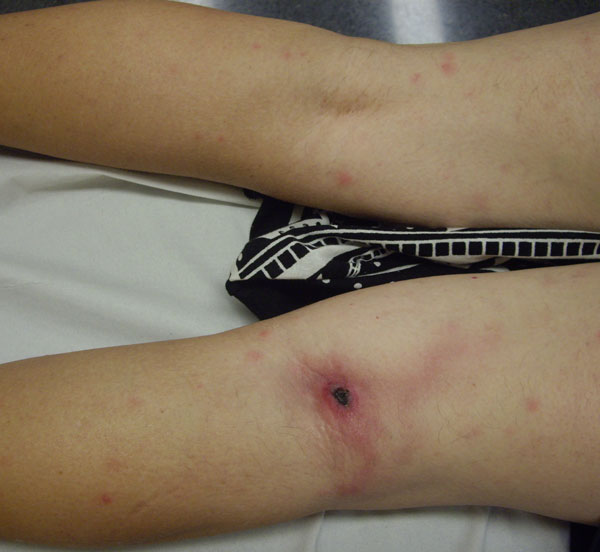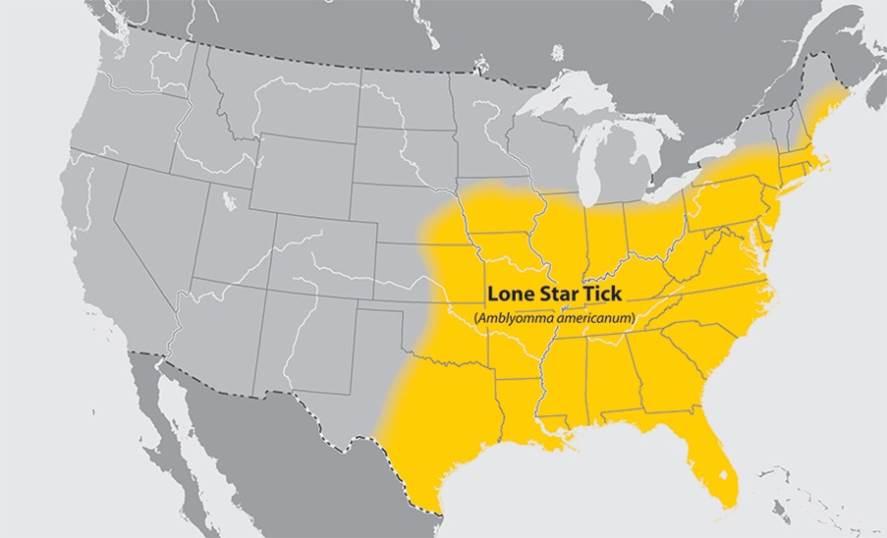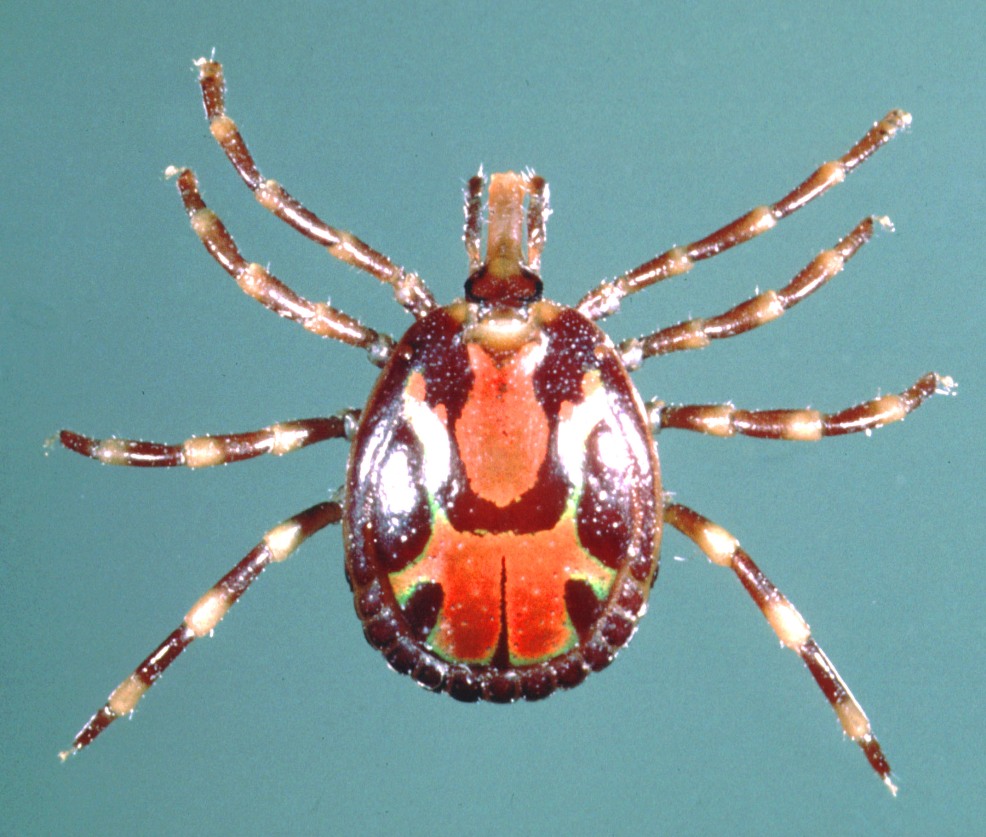|
American Tick Bite Fever
''Rickettsia parkeri'' (abbreviated ''R. parkeri'') is a gram-negative intracellular bacterium. The organism is found in the Western Hemisphere and is transmitted via the bite of hard ticks of the genus ''Amblyomma''. ''R. parkeri'' causes mild spotted fever disease in humans, whose most common signs and symptoms are fever, an eschar at the site of tick attachment, rash, headache, and muscle aches. Doxycycline is the most common drug used to reduce the symptoms associated with disease. Biology ''R. parkeri'' is classified in the spotted fever group of the genus ''Rickettsia''. Genetically, its close relatives include '' R. africae'', '' R. sibirica'', '' R. conorii'', '' R. rickettsii'', '' R. peacockii'', and '' R. honei''. The organism has been isolated from numerous species of ticks in the genus ''Amblyomma'': '' A. americanum'' in the United States; ''A. aureolatum'' in Brazil; '' A. maculatum'' in Mexico, Peru, and the United States; '' A. nodosum'' in Brazil; ''A. oval ... [...More Info...] [...Related Items...] OR: [Wikipedia] [Google] [Baidu] |
Eschar
An eschar (; Greek: ''ἐσχάρᾱ'', ''eskhara''; Latin: ''eschara'') is a slough or piece of dead tissue that is cast off from the surface of the skin, particularly after a burn injury, but also seen in gangrene, ulcer, fungal infections, necrotizing spider bite wounds, tick bites associated with spotted fevers and exposure to cutaneous anthrax. The term ‘eschar’ is not interchangeable with ‘scab’. An eschar contains necrotic tissue whereas a scab is composed of dried blood and exudate. Black eschars are most frequently attributed in medicine to cutaneous anthrax (infection by '' Bacillus anthracis''), which may be contracted through herd animal exposure and also from ''Pasteurella multocida'' exposure in cats and rabbits. A newly identified human rickettsial infection, ''R. parkeri'' rickettsiosis, can be differentiated from Rocky Mountain spotted fever by the presence of an eschar at the site of inoculation. Eschar is sometimes called a ''black wound'' becau ... [...More Info...] [...Related Items...] OR: [Wikipedia] [Google] [Baidu] |
Amblyomma Americanum
''Amblyomma americanum'', also known as the lone star tick, the northeastern water tick, or the turkey tick, or the "Cricker Tick", is a type of tick indigenous to much of the eastern United States and Mexico, that bites painlessly and commonly goes unnoticed, remaining attached to its host for as long as seven days until it is fully engorged with blood. It is a member of the phylum Arthropoda, class Arachnida. The adult lone star tick is sexually dimorphic, named for a silvery-white, star-shaped spot or "lone star" present near the center of the posterior portion of the adult female shield (scutum); adult males conversely have varied white streaks or spots around the margins of their shields. ''A. americanum'' is also referred to as the turkey tick in some Midwestern U.S. states, where wild turkeys are a common host for immature ticks. It is the primary vector of ''Ehrlichia chaffeensis'', which causes human monocytic ehrlichiosis, and ''Ehrlichia ewingii'', which causes human a ... [...More Info...] [...Related Items...] OR: [Wikipedia] [Google] [Baidu] |
Systematic Review
A systematic review is a Literature review, scholarly synthesis of the evidence on a clearly presented topic using critical methods to identify, define and assess research on the topic. A systematic review extracts and interprets data from published studies on the topic, then analyzes, describes, and summarizes interpretations into a refined conclusion. For example, a systematic review of randomized controlled trials is a way of summarizing and implementing evidence-based medicine. While a systematic review may be applied in the Biomedical research, biomedical or health care context, it may also be used where an assessment of a precisely defined subject can advance understanding in a field of research. A systematic review may examine clinical tests, public health interventions, environmental interventions, social interventions, adverse effects, qualitative evidence syntheses, methodological reviews, policy reviews, and economic evaluations. An understanding of systematic review ... [...More Info...] [...Related Items...] OR: [Wikipedia] [Google] [Baidu] |
Rocky Mountain Spotted Fever
Rocky Mountain spotted fever (RMSF) is a bacterial disease spread by ticks. It typically begins with a fever and headache, which is followed a few days later with the development of a rash. The rash is generally made up of small spots of bleeding and starts on the wrists and ankles. Other symptoms may include muscle pains and vomiting. Long-term complications following recovery may include hearing loss or loss of part of an arm or leg. The disease is caused by ''Rickettsia rickettsii'', a type of bacterium that is primarily spread to humans by American dog ticks, Rocky Mountain wood ticks, and brown dog ticks. Rarely the disease is spread by blood transfusions. Diagnosis in the early stages is difficult. A number of laboratory tests can confirm the diagnosis but treatment should be begun based on symptoms. It is within a group known as spotted fever rickettsiosis, together with ''Rickettsia parkeri'' rickettsiosis, Pacific Coast tick fever, and rickettsialpox. Treatment of ... [...More Info...] [...Related Items...] OR: [Wikipedia] [Google] [Baidu] |
Immunofluorescence
Immunofluorescence is a technique used for light microscopy with a fluorescence microscope and is used primarily on microbiological samples. This technique uses the specificity of antibodies to their antigen to target fluorescent dyes to specific biomolecule targets within a cell, and therefore allows visualization of the distribution of the target molecule through the sample. The specific region an antibody recognizes on an antigen is called an epitope. There have been efforts in epitope mapping since many antibodies can bind the same epitope and levels of binding between antibodies that recognize the same epitope can vary. Additionally, the binding of the fluorophore to the antibody itself cannot interfere with the immunological specificity of the antibody or the binding capacity of its antigen. Immunofluorescence is a widely used example of immunostaining (using antibodies to stain proteins) and is a specific example of immunohistochemistry (the use of the antibody-antigen rel ... [...More Info...] [...Related Items...] OR: [Wikipedia] [Google] [Baidu] |
Polymerase Chain Reaction
The polymerase chain reaction (PCR) is a method widely used to rapidly make millions to billions of copies (complete or partial) of a specific DNA sample, allowing scientists to take a very small sample of DNA and amplify it (or a part of it) to a large enough amount to study in detail. PCR was invented in 1983 by the American biochemist Kary Mullis at Cetus Corporation; Mullis and biochemist Michael Smith (chemist), Michael Smith, who had developed other essential ways of manipulating DNA, were jointly awarded the Nobel Prize in Chemistry in 1993. PCR is fundamental to many of the procedures used in genetic testing and research, including analysis of Ancient DNA, ancient samples of DNA and identification of infectious agents. Using PCR, copies of very small amounts of DNA sequences are exponentially amplified in a series of cycles of temperature changes. PCR is now a common and often indispensable technique used in medical laboratory research for a broad variety of applications ... [...More Info...] [...Related Items...] OR: [Wikipedia] [Google] [Baidu] |
Centers For Disease Control And Prevention
The Centers for Disease Control and Prevention (CDC) is the national public health agency of the United States. It is a United States federal agency, under the Department of Health and Human Services, and is headquartered in Atlanta, Georgia. The agency's main goal is the protection of public health and safety through the control and prevention of disease, injury, and disability in the US and worldwide. The CDC focuses national attention on developing and applying disease control and prevention. It especially focuses its attention on infectious disease, food borne pathogens, environmental health, occupational safety and health, health promotion, injury prevention and educational activities designed to improve the health of United States citizens. The CDC also conducts research and provides information on non-infectious diseases, such as obesity and diabetes, and is a founding member of the International Association of National Public Health Institutes. [...More Info...] [...Related Items...] OR: [Wikipedia] [Google] [Baidu] |
Rickettsiosis
A rickettsiosis is a disease caused by intracellular bacteria. Cause Rickettsioses can be divided into a spotted fever group (SPG) and typhus group (TG). In the past, rickettsioses were considered to be caused by species of Rickettsia. However, scrub typhus is still considered a rickettsiosis, even though the causative organism has been reclassified from ''Rickettsia tsutsugamushi'' to ''Orientia tsutsugamushi''.Examples of rickettsioses include typhus, both endemic and epidemic, Rocky Mountain spotted fever, and Rickettsialpox. Organisms involved include Rickettsia parkeri. Many new causative organisms have been identified in the last few decades. Most are in the genus ''Rickettsia'', but scrub typhus is in the genus '' Orientia''. Diagnosis No rapid laboratory tests are available to diagnose rickettsial diseases early in the course of illness, and serologic assays usually take 10–12 days to become positive. Research is indicating that swabs of eschars may be used for molecul ... [...More Info...] [...Related Items...] OR: [Wikipedia] [Google] [Baidu] |
Tidewater Region
Tidewater refers to the north Atlantic coastal plain region of the United States of America. Definition Culturally, the Tidewater region usually includes the low-lying plains of southeast Virginia, northeastern North Carolina, southern Maryland and the Chesapeake Bay. Speaking geographically, however, it covers about 50,000 square miles, from New York's Long Island in the north to the southernmost edge of North Carolina in the south, an area that includes the state of Delaware and the Delmarva Peninsula. The cultural Tidewater region got its name from the effects of the changing tides on local rivers, sounds, and the ocean. The area has a centuries-old cultural heritage that sets the Tidewater region apart from the adjacent inland parts of the United States, especially with respect to its distinctive dialects of English, which are gradually disappearing, along with its islands and its receding shoreline. Geography The tidewater region developed when sea level rose after ... [...More Info...] [...Related Items...] OR: [Wikipedia] [Google] [Baidu] |
African Tick Bite Fever
African tick bite fever (ATBF) is a bacterial infection spread by the bite of a tick. Symptoms may include fever, headache, muscle pain, and a rash. At the site of the bite there is typically a red skin sore with a dark center. The onset of symptoms usually occurs 4–10 days after the bite. Complications are rare but may include joint inflammation. Some people do not develop symptoms. Tick bite fever is caused by the bacterium '' Rickettsia africae''. The bacterium is spread by ticks of the ''Amblyomma'' type. These generally live in tall grass or bush rather than in cities. The diagnosis is typically based on symptoms. It can be confirmed by culture, PCR, or immunofluorescence. There is no vaccine. Prevention is by avoiding tick bites by covering the skin, using DEET, or using permethrin treated clothing. Evidence regarding treatment, however, is limited. The antibiotic doxycycline appears useful. Chloramphenicol or azithromycin may also be used. The disease will also t ... [...More Info...] [...Related Items...] OR: [Wikipedia] [Google] [Baidu] |
American Tick Bite Fever
''Rickettsia parkeri'' (abbreviated ''R. parkeri'') is a gram-negative intracellular bacterium. The organism is found in the Western Hemisphere and is transmitted via the bite of hard ticks of the genus ''Amblyomma''. ''R. parkeri'' causes mild spotted fever disease in humans, whose most common signs and symptoms are fever, an eschar at the site of tick attachment, rash, headache, and muscle aches. Doxycycline is the most common drug used to reduce the symptoms associated with disease. Biology ''R. parkeri'' is classified in the spotted fever group of the genus ''Rickettsia''. Genetically, its close relatives include '' R. africae'', '' R. sibirica'', '' R. conorii'', '' R. rickettsii'', '' R. peacockii'', and '' R. honei''. The organism has been isolated from numerous species of ticks in the genus ''Amblyomma'': '' A. americanum'' in the United States; ''A. aureolatum'' in Brazil; '' A. maculatum'' in Mexico, Peru, and the United States; '' A. nodosum'' in Brazil; ''A. oval ... [...More Info...] [...Related Items...] OR: [Wikipedia] [Google] [Baidu] |
Boutonneuse Fever
Boutonneuse fever (also called, Mediterranean spotted fever, ''fièvre boutonneuse'', Kenya tick typhus, Indian tick typhus, Marseilles fever, or Astrakhan fever) is a fever as a result of a rickettsial infection caused by the bacterium '' Rickettsia conorii'' and transmitted by the dog tick ''Rhipicephalus sanguineus''. Boutonneuse fever can be seen in many places around the world, although it is endemic in countries surrounding the Mediterranean Sea. This disease was first described in Tunisia in 1910 by Conor and Bruch and was named ''boutonneuse'' ( French for "spotty") due to its papular skin-rash characteristics. Presentation After an incubation period around seven days, the disease manifests abruptly with chills, high fevers, muscular and articular pains, severe headache, and photophobia. The location of the bite forms a black, ulcerous crust (''tache noire''). Around the fourth day of the illness, a widespread rash appears, first macular and then maculopapular, and sometime ... [...More Info...] [...Related Items...] OR: [Wikipedia] [Google] [Baidu] |







